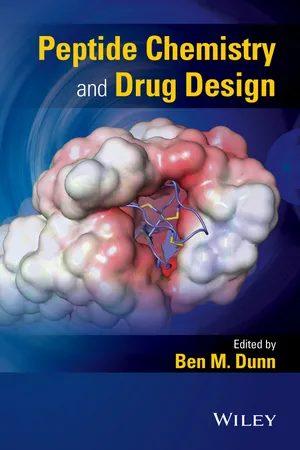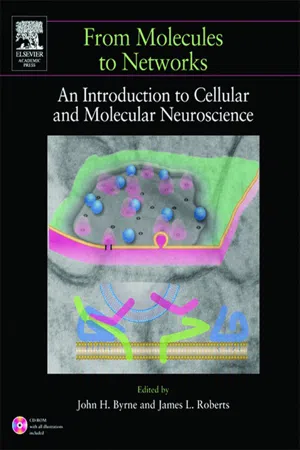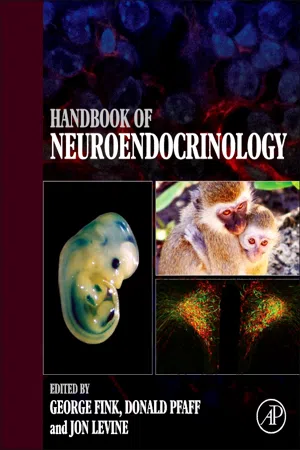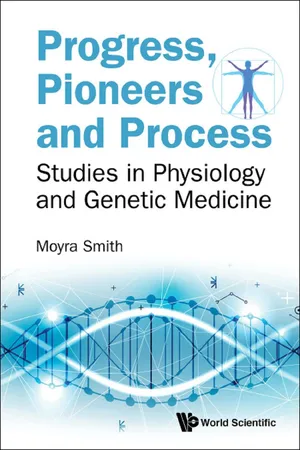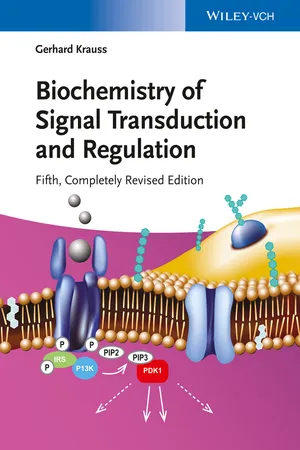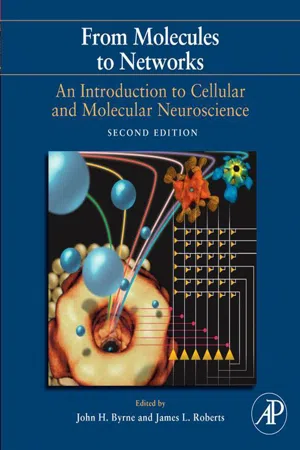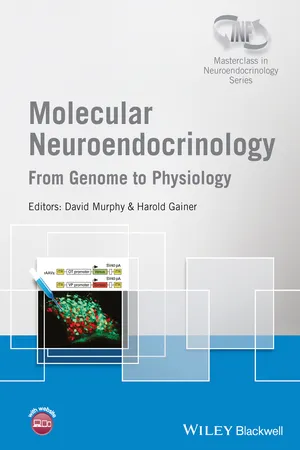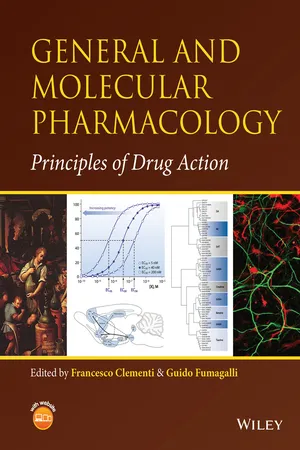Biological Sciences
G Protein-Coupled Receptors
G protein-coupled receptors (GPCRs) are a large family of cell surface receptors that play a crucial role in transmitting signals from the extracellular environment to the inside of the cell. They are involved in a wide range of physiological processes, including sensory perception, neurotransmission, and hormone regulation. Upon activation by a ligand, GPCRs initiate intracellular signaling through interaction with G proteins.
Written by Perlego with AI-assistance
Related key terms
Related key terms
1 of 4
Related key terms
1 of 3
11 Key excerpts on "G Protein-Coupled Receptors"
- eBook - ePub
- Ben M. Dunn(Author)
- 2015(Publication Date)
- Wiley(Publisher)
3 Peptide Design Strategies for G-Protein Coupled Receptors (GPCR) Anamika Singh and Carrie Haskell-LuevanoDepartment of Medicinal Chemistry, University of Minnesota, Minneapolis, MN, USA3.1 Introduction
The plasma membrane of mammalian cells separates the extracellular and intracellular environments and can function as a messenger to carry information across a cell membrane to the interior of the cell, thus providing a mechanism of communication. Membrane proteins represent a large and versatile group of protein sensors that are involved in diverse physiological processes, such as neurotransmission, cellular metabolism, secretion, cellular differentiation, growth, inflammation, and immune responses, and are thus primary targets for drug discovery [1]. Peptides act as a primary source of intercellular communication in many diverse biological systems by interacting with their corresponding receptors. A large subset of these receptors couple with guanine-nucleotide binding proteins (G-proteins) to produce a signal transduction cascade of cellular actions, hence called G-protein coupled receptors (GPCRs).GPCRs consist of seven α-helical transmembrane (TM) segments and represent the largest family of membrane proteins in the human genome. Molecular cloning studies and genome data analysis have revealed nearly 1000 members of the GPCR super family, which is the largest group of membrane-spanning surface receptors on human cells [2, 3]. GPCRs respond to a diverse range of extracellular stimuli, such as neurotransmitters, peptide hormones, amino acids, amines, lipids, sugars, and even photons and cations, and thus assist in variety of different functions [1]. GPCRs represent major targets for the development of novel drug candidates in all clinical areas. It is estimated that 30% of clinically prescribed drugs function as either agonists or antagonists at GPCRs, which highlights their immense therapeutic potential [2, 4–6]. - eBook - ePub
Muscle 2-Volume Set
Fundamental Biology and Mechanisms of Disease
- Joseph Hill, Eric Olson(Authors)
- 2012(Publication Date)
- Academic Press(Publisher)
Chapter 8
G-Protein-Coupled Receptors in the Heart
Melissa L. Martin, Stephen L. Belmonte, Rashmi Ram, Fadia A. Kamal and Burns C. Blaxall Aab Cardiovascular Research Institute, Department of Medicine, University of Rochester School of Medicine and Dentistry, Rochester, NYIntroduction
The heart is a functionally dynamic organ that rapidly adapts to the constantly changing energetic and metabolic demands of the body. It is exposed to a dynamic array of stimuli, including hormones, neurotransmitters, cytokines, and peptides, that can modulate heart rate, contractility, metabolic homeostasis, and energy utilization of this vital organ. The heart responds to various inputs through intricate signal transduction systems that convert the dynamic array of stimuli into intracellular changes that allow for the appropriate regulation of cardiac function. The most extensively studied and pervasive means by which the heart transmits these signals is mediated via a large group of diverse proteins known as G-protein-coupled receptors, or GPCRs. GPCRs are a ubiquitous family of seven transmembrane proteins that are uniquely designed to translate extracellular messages into physiological responses. As the largest known superfamily of membrane-bound receptors, and with over 200 types of GPCRs in the heart, it is no surprise that the extensive study of these receptors and their subsequent signaling has greatly increased our understanding of cardiac function and regulation (1) . However, several decades of research has demonstrated that unbalanced, dysregulated or excessive signaling via these receptors also governs much of the observed pathophysiology in a variety of chronic cardiac diseases (2) . Consequently, GPCRs have become the most commonly targeted class of molecules for cardiovascular therapeutics (1) . Despite this, cardiac disease, including heart failure (HF), which is characterized by aberrant GPCR signaling, continues to be a tremendous public health burden and a leading cause of morbidity and mortality, responsible for more than one in five deaths in the United States alone (3) , underscoring the insufficiency of current long-term treatment options (4) - eBook - ePub
From Molecules to Networks
An Introduction to Cellular and Molecular Neuroscience
- John H. Byrne, Ruth Heidelberger, M. Neal Waxham, James L. Roberts(Authors)
- 2003(Publication Date)
- Academic Press(Publisher)
Chapter 16 ). The relatively slow speed is offset, however, by a richness in the diversity of its modulation and its inherent capacity for amplification and plasticity. The initial steps in this signaling system typically generate a second messenger inside the cell, and this second messenger then activates a number of proteins, including protein kinases that modify cellular processes. Signal transduction also modulates the level of transcription of genes, which determine the differentiated and functional state of cells.SIGNALING THROUGH G-PROTEIN-LINKED RECEPTORS
Signal transduction through G protein-linked receptors requires three membrane-bound components: (1) a cell surface receptor that determines to which signal the cell can respond; (2) a G protein on the intracellular side of the membrane that is stimulated by the activated receptor; and (3) either an effector enzyme that changes the level of a second messenger or an effector channel that changes ionic fluxes in the cell in response to the activated G protein. The human genome encodes for more than 600 receptors for catecholamines, odorants, neuropeptides, and light that couple to one or more of the 27 identified G proteins. These, in turn, regulate one or more of more than two dozen different effector channels and enzymes. The key feature of this information flow is the ability of G proteins to detect the presence of activated receptors and to amplify the signal by altering the activity of appropriate effector enzymes and channels.G proteins are GTP-binding proteins that couple the activation of seven-helix receptors by neurotransmitters at the cell surface to changes in the activity of effector enzymes and effector channels. A common effector enzyme is adenylyl cyclase, which synthesizes cyclic AMP—an intracellular surrogate for the neurotransmitter, the first messenger. Phospholipase C (PLC), another effector enzyme, generates diacylglycerol (DAG) and inositol trisphosphate (IP3), the latter of which releases intracellular stores of Ca2+ . Information from an activated receptor flows to the second messengers that typically activate protein kinases, which modify a host of cellular functions. Cyclic AMP, Ca2+ , and DAG have in common the ability to activate protein kinases with broad substrate specificities. They phosphorylate key intracellular proteins, ion channels, enzymes, and transcription factors taking part in diverse cellular biological processes. The activities of protein kinases and phosphatases are in balance, constituting a highly regulated process, as revealed by the phosphorylation state of these targets of the signal transduction process. In addition to regulating protein kinases, second messengers such as cAMP, cGMP, Ca2+ , and arachidonic acid can directly gate, or modulate, ion channels. G proteins can also couple directly to ion channels without the interception of second messengers or protein kinases. In these diverse ways, a neurotransmitter outside the cell can modulate essentially every aspect of cell physiology and encode the history of cell stimuli in the form of altered activity and expression of its cellular constituents. An overview of G-protein signaling to protein kinases is presented in Fig. 12.1 - eBook - ePub
- George Fink, Donald W. Pfaff, Jon Levine(Authors)
- 2011(Publication Date)
- Academic Press(Publisher)
Fig. 2.5 , the first levels of GPCR regulation are gene transcription, translation and post-translational processing, which may be regulated by the ligand itself and by other hormones and factors that regulate the neuroendocrine system. The synthesized receptor may also be further regulated by other sets of proteins in its trafficking to the membrane of the cell. On arrival at the cell surface the GPCR may associate with numerous membrane and intracellular proteins, which will potentially alter ligand affinity, ligand selectivity, signaling, cytoskeletal and extracellular matrix interactions and internalization. In addition, GPCRs may undergo homo- or hetero-oligomerization to induce transactivation of other receptors or lead to signal modification. GPCR phosphorylation, acetylation, palmitoylation, ubiquitination and myristoylation also modify receptor functional properties. Clearly, the integrated effects of all these possibilities in regulating the neuroendocrine system are vast.FIGURE 2.5 Potential mechanisms for regulation of GPCRs. Schematic describing how GPCRs can be regulated at many levels: from their biosynthesis (gene transcription, translation and post-translational processing) through their trafficking to the cell membrane and, once at the cell surface, through oligomerization and interactions with various other non-receptor proteins or through modifications such as differential phosphorylation.Differential Receptor Phosphorylation
The effects of differential receptor phosphorylation on signaling events have recently been reviewed. 29 Using the M3 muscarinic receptor as an example, characteristic fingerprints of receptor phosphorylation were demonstrated in different cells, each with its own spectrum of kinases. Each fingerprint imparts both a different flavor of signaling and a different phenotype of effects in cells. The M3 receptor has also been mutated so that certain types of phosphorylation cannot take place, and when transgenically knocked into mice they have produced differential phenotypes, demonstrating the importance of differential phosphorylation in regulation of cellular responses to GPCR activation. 29 - eBook - ePub
Progress, Pioneers and Process
Studies in Physiology and Genetic Medicine
- Moyra Smith(Author)
- 2018(Publication Date)
- WSPC(Publisher)
et al . noted that through biochemical studies of the Gs pathway, a number of key concepts emerged. These involved concepts of protein phosphorylation, second messengers, signal transducers, and elucidation of regulatory proteins such as GTPases. The Gs category of G proteins was found to be important in downstream activation of the mitogen-activated protein kinase (MAPK or MAP kinase) signaling pathways.The G1 and Go protein pathways were found to be important in conducting signals initiated by binding of specific hormones and neurotransmitters to their receptors. The Gq pathway include proteins that interacted downstream with intracellular pathways that included inositol triphosphate and diacyl glycerol.Milligan and Kostenis (2006) noted that the G protein family has been highly conserved during evolution.The function of G proteins centers on their ability to bind guanine nucleotides. G proteins bind guanine diphosphate (GDP) and then exchange this for GTP when activated. GTP binding to G proteins is regulated by guanine nucleotide exchange factors (GEFs) and activation is terminated through activity of GTPase activating factors (GAPs). Bos et al . (2007) reviewed GEFs and GAPs and reported that these are multi-domain proteins. Specific forms of GEFs and GAPs interact with specific forms of G proteins.Activated small G proteins act as transducers of effectors that in turn promote the synthesis of second messengers such as cyclic AMP that activate the intracellular signaling processes.7.4Cell Membranes and ReceptorsPioneering studies, such as those described above, have led to consolidation of concepts regarding transfer of information to the interior of the cell to regulate processes.The outer membranes of cells act as a barrier to the transfer of all molecules except small lipid-soluble molecules. Key transfer mechanisms include ion channels that open and close and allow transfer of ions such as sodium and calcium. Solute carriers are small proteins that act as transporters. In addition, specific receptors on the outer cell membrane may bind specific molecules and transfer these ligands to the interior of the cell. Binding of ligands can influence the conformation and function of the internal cytoplasmic region of the receptors that are activated by binding to the ligand. This activation impacts a series of proteins in the cell signal transduction pathways. - Gerhard Krauss(Author)
- 2014(Publication Date)
- Wiley-VCH(Publisher)
A subset of lipid rafts, the caveolae, are characterized by the presence of the protein caveolin at the cytoplasmic side. By assembling various components of the GPCR signaling path within such microdomain as supramolecular complexes, a high local concentration of the reaction partners of the signaling chain is achieved. Such supramolecular assemblies are thought to ensure a high efficiency and specificity of signaling. For example, γ-aminobutyric acid (GABA) receptors (which are GPCRs) have been shown to exist in higher complexes comprised of receptor oligomers, G i subunits, adenylyl cyclase and K + channels [17]. 7.5.4 Structural and Mechanistic Aspects of the Switch Function of G Proteins The reaction cycle of the heterotrimeric G proteins involves the formation and breaking of numerous protein–protein contacts. In a dynamic way, protein–protein interactions are formed and resolved during the cycle, defining distinct states of the G protein and leading to new functions and reactions. Currently, a wealth of structural information is available for most of the distinct functional states of the heterotrimeric G proteins. 7.5.4.1 Coupling of the Activated Receptor to the G Protein How an activated receptor activates the downstream G protein can be inferred mainly from the recent studies on the β 2 AR in complex with a G αβγ heterotrimer (Section 7.3.2.3). These studies indicate a major involvement of the transmembrane helices TM5, TM7 and the intracellular loop ICL3 in the recognition and stabilization of the complex with G αβγ. In this complex, the heterotrimer contacts the GPCR via the G α -subunit. Rhodopsin: GPCR activated by light in the vision process Light-induced activation of rhodopsin triggers reorientation of TM helices 3, 6, and 7. 7.5.4.2 Structure of the G α -subunit The switch function of the α-subunit of the heterotrimeric G proteins is founded on the change between an active G α ·GTP conformation and an inactive G α ·GDP conformation- eBook - ePub
Biochemical Targets of Plant Bioactive Compounds
A Pharmacological Reference Guide to Sites of Action and Biological Effects
- Gideon Polya(Author)
- 2003(Publication Date)
- CRC Press(Publisher)
5 Plasma membrane G Protein-Coupled Receptors
5.1 Introduction – signalling via heterotrimeric G proteins
A major hormone signal transduction mechanism involves heterotrimeric guanyl nucleotide-binding protein (G protein) complexes. Hormone binding to a specific plasma membrane (PM)-located G protein-coupled receptor (GPCR) gives a hormone–receptor complex (H–R) that interacts with a PM-located heterotrimeric G protein complex (GDP–G α–G β–G γ) in which the guanyl nucleotide guanosine 5 ´-diphosphate (GDP) is bound to the G α subunit. This H–R complex–G protein interaction causes release of G βG γ, dissocia tion of GDP and replacement of GDP on G α with guanosine 5 ´-triphos-phate (GTP) to form an “activated” G α–GTP complex. The active G α–GTP complex activates downstream “effector” enzymes depending upon the specific type of G α (as detailed below). The activation process is reversed through the GTP hydrolysing (GTPase) activity of the G α subunit generating G α–GDP, w hich can then ercombine with G βG γ to re-form the inactive G α–GDP–G βG γ complex.This reversible activation/deactivation process can be summarized as follows: H +PM R¨H–R¨H–R–G α–GDP–G β–G γ interaction¨H–R +G α–GTP +G β–G γ complex¨ active G α–GTP activates effector proteins¨downstream effects; deactivation occurs via the GTPase activity of G α so that G α–GTP¨G α–GDP +Pi ¨G α–GDP binds G β–G γ¨the inactive GDP–G α–G β–G γ complex is re-formed.The activation of effector proteins by G α–GTP complexes to ultimately cause the cellular responses to the initial hormone signal depends upon the specific type of G α subunit activated. A variety of G proteins have been resolved and characterized. In addition to their effector protein specificity, the G α subunits can be distinguished by their modification by particular bacterial toxins. Thus the Vibrio cholerae (cholera) toxin adenosine 5 ´-diphosphate (ADP)-ribosylates G αs, G αt and G αolf entities, ther eby inhibiting their GTPase activity and keeping these proteins in the persistently activated G α–GTP form. The Bordetella pertussis (whooping cough) toxin (pertussis toxin) ADP-ribosylates G αi, G αo, G αg and G αt entities, thereby preventing GDP release and keeping these proteins in the inactive GDP– G αs–G β–G γ form. The effector specificities of the different G α proteins and their differential effects on membrane potential and the cytosolic levels of “second messengers” such as adenosine 3 ´,5 ´-cyclic monophosphate (cAMP), inositol-1,4,5-triphospate (IP3 ) and Ca2+ - eBook - ePub
From Molecules to Networks
An Introduction to Cellular and Molecular Neuroscience
- Ruth Heidelberger, M. Neal Waxham, John H. Byrne, James L. Roberts(Authors)
- 2009(Publication Date)
- Academic Press(Publisher)
et al ., 2000). These significant structural distinctions support the idea that mGluRs evolved separately from other GPCRs. The third intracellular loop, thought to be the major determinant responsible for G-protein coupling of mGluRs is relatively small, whereas the C-terminal domain is quite large. The coupling between mGluRs and their respective G proteins may be through unique determinants that exist in the large C-terminal domain.Currently, eight different mGluRs can be subdivided into three groups on the basis of sequence homologies and their capacity to couple to specific enzyme systems. Both mGluR1 and mGluR5 activate a G protein coupled to phospholipase C. mGluR1 activation can also lead to the production of cAMP and arachidonic acid, by coupling to G proteins that activate adenylyl cyclase and phospholipase A2 (Aramori and Nakanishi, 1992 ). mGluR5 seems more specific, activating predominantly the G-protein-activated phospholipase C.The other six mGluR subtypes are distinct from one another in favoring either trans -1-aminocyclopentane-1,3-dicarboxylate (mGluR2 , mGluR3 , and mGluR8 ) or 1,2-amino-4-phosphonobutyrate (mGluR4 , mGluR6 , and mGluR7 ) as agonists for activation. mGluR2 and mGluR4 can be further distinguished pharmacologically by using the agonist 2-(carboxycyclopropyl)glycine, which is more potent at activating mGluR2 receptors (Hayashi et al ., 1992). Less is known about the mechanisms by which these receptors produce intracellular responses; however, one effect is to inhibit the production of cAMP by activating an inhibitory G protein.mGluRs are widespread in the nervous system and are found both pre- and postsynaptically. Presynaptically, they serve as autoreceptors and appear to participate in the inhibition of neurotransmitter release. Their postsynaptic roles appear to be quite varied and depend on the specific G protein to which they are coupled. mGluR1 activation has been implicated in long-term synaptic plasticity at many sites in the brain, including long-term potentiation in the hippocampus and long-term depression in the cerebellum (see Chapter 19 - eBook - ePub
Molecular Neuroendocrinology
From Genome to Physiology
- David Murphy, Harold Gainer(Authors)
- 2015(Publication Date)
- Wiley-Blackwell(Publisher)
et al., 2013a).Many GPCRs, including those that are activated by neuropeptides, appear to exist as dimers or higher-order oligomers, and homo/heterodimerization of two (or occasionally the functional interaction between three) GPCRs has been demonstrated predominantly in in vitro experiments (Milligan, 2013; see the G protein-coupled receptor-oligomerization knowledge base project, http://data.gpcr-okb.org/gpcr-okb/ ). GPCR oligomerization may be mediated principally by interaction between TM domains and/or intracellular regions (Katrich et al., 2012; Milligan, 2013). It has proved difficult to detect in vivo, although ‘heteromer-specific’ monoclonal antibodies have been used to detect μ−δ opioid receptor oligomerization in brain sections, and OXT receptor dimerization has been demonstrated using fluorescently labeled OXT agonists in breast tissue where these receptors are highly expressed (Milligan, 2013). We know from the examples of GABAB and taste receptors (both requiring the interaction between two GPCRs for activity) that stable, functional GPCR oligomerization does occur in vivo, and that heterodimerization can alter the pharmacological profiles (for example, desensitization, G protein coupling, signaling pathways) of one or both members of the heterodimer (Milligan, 2013). With likely over 100 neuropeptide receptors co-expressed in individual neurons, the potential for heterodimerization is enormous, and in in vitro studies oligomerization is prevalent between GPCRs found in neuroendocrine systems (Kamal and Jockers, 2011). Even constitutively active orphan GPCRs may heterodimerize with neuropeptide GPCRs to alter the latter’s function – an example of this is the orphan GPCR GPR50 that heterodimerizes with the melatonin MT1 receptor to inhibit its activity (Hazell et al., 2012). In addition, neuropeptide receptors may also heterodimerize with other membrane signaling molecules such as ion channels (Hazell et al - eBook - ePub
- Dr P Revest, Alan Longstaff(Authors)
- 1998(Publication Date)
- Garland Science(Publisher)
As well as the receptors for neurotransmitters and hormones, members of the G protein-linked family are sensory transducers. They mediate the response to light by the rod and cone cells, using the molecules rhodopsin and color opsins. Receptors for the chemical senses, taste and smell, are also G protein-linked receptors, and it is thought that the odorant receptors may have the largest number of receptor subtypes yet found, with estimates ranging from 400 to 1000 distinct receptors. Interestingly, these different receptors are not produced by alternative splicing of a small number of genes but it seems that each receptor is coded by a distinct gene.In order to give an idea of the diversity of G protein-linked receptors, the subtypes for some of the receptors are listed in Table 6.1 . However, this list is not exhaustive. Many of these receptors have been first identified from their genes using low-stringency probes based on sequences from other G protein-linked receptors.6.4 G protein-linked receptors share a common structure
The significant homologies between many of these receptors is mirrored in their common predicted structure. All of these receptors are thought to have seven transmembrane-spanning segments which gives rise to an alternative name for these receptors as seven transmembrane (7TM) receptors (Figure 6.2 ).They all have an extracellular N terminus of widely varying size, and a cytoplasmic C terminus. Many of these receptors also have an extended cytoplasmic loop between the S5 and S6 segments.The proposed arrangement of the TM segments in the membrane was based originally on X-ray diffraction - eBook - ePub
General and Molecular Pharmacology
Principles of Drug Action
- Francesco Clementi, Guido Fumagalli(Authors)
- 2015(Publication Date)
- Wiley(Publisher)
Molecular Interventions, 2, 293–307.- Rosenfelt R., Devi L.A. (2010). Receptor heteromerization and drug discovery.
Trends in Pharmacological Sciences, 31, 124–130.Intracellular Receptors
- Gemain P., Staels B., Dacquet C., Spedding M., Laudet V. (2006). Overview of nomenclature of nuclear receptors. Pharmacological Reviews, 58, 685–704.
- Mor A., White M.A., Fontoura B.M. (2014). Nuclear trafficking in health and disease. Current Opinion in Cell Biology, 28C, 28–35. doi: 10.1016/j.ceb.2014.01.007.
- The British Pharmacological Society (2009). Nuclear receptors. British Journal of Pharmacology, 158, S157–S167.
Ligand-gated Ion Channels
- Calimet N., Simoes M., Changeux J.P., Karplus M., Taly A., Cecchini M. (2013). A gating mechanism of pentameric ligand-gated ion channels. Proceeding of the National Academy of Sciences USA, 110, 3987–3996.
- Changeaux J.P., Edelstein S.J. (1998). Allosteric receptors after 30 years. Neuron, 27, 959–980.
- Lodge D. (2009). The history of the pharmacology and cloning of ionotropic glutamate receptors and the development of idiosyncratic nomenclature. Neuropharmacology, 56, 6–21.
- Millar N.S., Gotti C. (2009). Diversity of vertebrate nicotinic acetylcholine receptors. Neuropharmacology, 56, 237–246.
- The British Pharmacological Society (2009). LGIC. British Journal of Pharmacology, 158, S103–S121. doi: 10.1111/j.1476-5381.2009.00502.
G Protein-Coupled Receptors
- Lagerstrom M.C., Schioth H.B. (2008). Structural diversity of G-protein-coupled receptors and significance for drug discovery. Nature Reviews in Drug Discovery, 7, 339–357.
- Pierce K.L., Premont R.T., Lefkowitz R.J. (2002). Seven-transmembrane receptors. Nature Reviews Molecular Cellular Biology, 3, 639–649.
- The British Pharmacological Society (2009). 7TM receptors. British Journal of Pharmacology, 158, S5–S101.
Catalytic Receptors
- Garbers D.L., Chrisman T.D., Wiegn P., Katafuchi T., et al. (2006). Membrane guanylyl cyclase receptors: an update. Trends in Endocrinology and Metabolism
Index pages curate the most relevant extracts from our library of academic textbooks. They’ve been created using an in-house natural language model (NLM), each adding context and meaning to key research topics.
Explore more topic indexes
Explore more topic indexes
1 of 6
Explore more topic indexes
1 of 4
